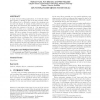Free Online Productivity Tools
i2Speak
i2Symbol
i2OCR
iTex2Img
iWeb2Print
iWeb2Shot
i2Type
iPdf2Split
iPdf2Merge
i2Bopomofo
i2Arabic
i2Style
i2Image
i2PDF
iLatex2Rtf
Sci2ools
DOCENG
2006
ACM
2006
ACM
Minimum sized text containment shapes
In many text-processing applications, we would like shapes that expand (or shrink) in size to fit their textual content. We address how to efficiently compute the minimum size for such text shapes. A variant of this problem is to take a fixed shape and determine the maximal size font that will still allow the content to fit into it. Our approach is to model the problem as a constrained optimisation problem with a single variable that controls the geometry of the text shape. We use a variant of secant search to determine the minimum area for the shape, guided by the area of the text. We represent the shape by regions that are composed of trapezoids whose coordinates are a linear function of the unknown variable. This allows us to use a novel linear time algorithm (based on computing Minkowski difference) that takes a trapezoid list and text height and determines the region in which a line of text of that height and some minimum width can start and still remain inside the shape. Cat...
| Added | 13 Jun 2010 |
| Updated | 13 Jun 2010 |
| Type | Conference |
| Year | 2006 |
| Where | DOCENG |
| Authors | Nathan Hurst, Kim Marriott, Peter Moulder |
Comments (0)

